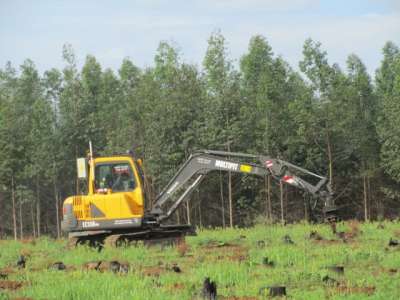Background
Artificial intelligence (AI) is known as the simulation of human intelligence by machines, especially computer systems. In its less sophisticated form, the AI field in forestry applications combines computer science and robust datasets to solve problems. Some of the subfields include machine learning and deep learning. Holistically, the systems make use of AI algorithms which aim to make predictions or classifications based on input data. Even though the application of AI in forestry applications (e.g., forest management) is wide and diverse, this article focuses on the adoption and potential application of AI technology in some modern silviculture operations.
Data and AI
AI can only function optimally in conjunction with other digital technologies such as big data, programming, software applications, sensor technology and IoT infrastructure. Machines in forestry can be used to collect data about inputs they use (e.g., seedlings, water/gel, fertilizer, chemical, fuel etc.) and outputs (machine productivity, operator techniques, application of resource inputs etc.). This data can be downloaded from the machine or accessed remotely via telematic systems. Furthermore, the incorporation of high-precision positioning systems, automated steering systems, geo-mapping, sensor and remote sensing, and integrated electronic communication combined with other surveillance and monitoring systems (e.g., drones, satellite systems) can supply accurate spatial data speedily which can be used to support AI based systems. Broadly, the use of AI in silviculture operations can assist with data driven decision making, cost reduction and facilitate automation in forest operations. Even though the use of AI in modern silviculture equipment is still in its infancy, it has good future prospects as the technology is increasingly being tested, applied and adopted. From observation, one can notice that the degree of AI incorporation in silvicultural machines is continuously increasing.
Examples of artificial intelligence in modern silviculture operations
Nursery operations
In nurseries AI has been incorporated in several ways. Digital systems can be used to measure key parameters such as chemical, irrigation, plant condition in near real time to ensure systems can be adjusted or changed in a relatively short time. An AI tool which is being used in nurseries in computer vision which enables the rapid assessment of plant quality. E.g., Using a phone camera and programming one can automate the measurements of plant heights within a tray in the nursery. This data can provide information to develop growth curves and assist with automated measurement of plant quality. Other sensing technology such as multispectral sensors and thermal imaging can be used to monitor issues such as plant health and water stress.
Planting and irrigation
AI can be used to improve planting quality (survival and subsequent growth) in mechanised operations. For example, in the PlantMax machine the planting arm has a sensor in the tip of the arm which detects when the tip hits the ground and conducts an evaluation of the suitability of the planting position (i.e. not too wet, not a rock or a stump of a tree etc). If the area is suitable planting occurs, if not the planting arm returns and plants a seedling in the next suitable location. Thereafter, the system recalibrates the spacing to ensure the required number of plants are still planted within the area. Furthermore, machines like the double/ triple irrigator can be used to perform irrigation autonomously by identifying the seedlings planted and applying the appropriate quantity of water to irrigate the plants.
Fertilizing, weeding, pest and diseases
Technologies such as computer vision systems which can be incorporated in equipment like drones, can be used to capture images of trees. The images can be analysed to support the accurate application of the required doses of nutrients based on plant foliage analysis, discolouration and stunted growth. In agriculture, the use of machine learning and computer vision for precision weeding, pest and disease detection and chemical application is being used effectively. This technology has the potential of being adopted at a wider scale within the forestry industry.
Future application of artificial intelligence in precision silviculture
Even though the application of AI technology in modern silviculture equipment can be considered to be still in the early phase, its application can be expected to grow exponentially within the next few years. As more data is collected and analysed it will help forestry stakeholders to make informed decisions. With the growth of AI, some foresters, contractors and organisations may find this technology complex and intimidating, however through being informed anyone can identify areas where AI can be used effectively to improve overall efficiencies whilst also being aware of the potential risks.
For more information, refer to the sources below:







